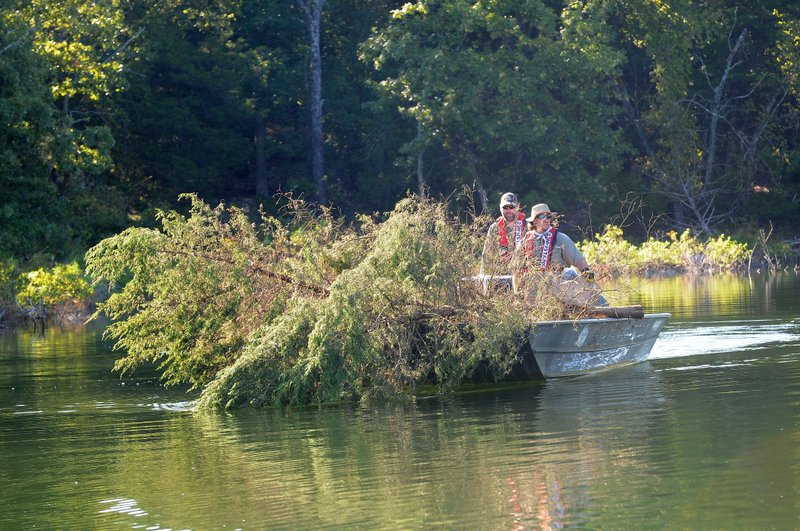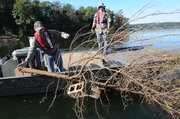Cedar trees are the over-achievers in the Ozark forests.
These prickly evergreens grow and propagate so fast they often prevent the growth of other trees. Woody browse that is food for wildlife doesn't stand a chance in the shadows cast by prolific cedar trees. Wildflowers? They're few and far between in a cedar thicket.
Fish finder
Anglers can find the location of cedar trees that have been submerged in Beaver Lake. Type agfc gis mapper into a search engine. Zoom in on Beaver Lake to see where trees have been placed.
— Staff report
Cedar trees are taking over the forest on the islands at Beaver Lake. Work by the Arkansas Game and Fish Commission aims to remove hundreds of cedar trees from three large islands to improve the health of the forest. The trees then become excellent fish habitat when they're sunk deep into the lake.
Swaths of cedar trees have already been cut from Deer Island and Bear Island east of the Prairie Creek park, said Jon Stein, fisheries biologist with Game and Fish. The project will stretch into the winter, he said, with about 800 cedar trees to be cut and sunk. Shaddox Island, near Rocky Branch park, is also in the cedar-removal plan.
All three islands are open for hiking, exploring, swimming from the shoreline and hunting with certain restrictions. Game and Fish manages the islands as the Beaver Lake Wildlife Management Area. Camping or campfires are not allowed.
Healthier Forest
Cedars have always been a part of the Ozarks landscape, said Mark Hutchings, a wildlife biologist with Game and Fish.
"There are cedars on the bluffs along the Buffalo River that are hundreds of years old," Hutchings said. The main reason cedars have spread so rapidly in modern times is a lack of fire.
Fires regularly swept across the landscape, caused by nature or intentionally set.
"Those fires killed the young cedar trees," Hutchings said. "What you had then was a much more open forest, a savanna-type forest with fewer but larger trees."
Stands of native grass grew among those trees.
What are cedar thickets across Northwest Arkansas now used to be glades, Hutchings said. Aerial photos of Deer and Bear Islands taken in the mid-1990s show a much more open forest with far fewer cedar trees.
"With so many cedars, their canopy shades the ground so hardly anything else can grow," he said. Removing some cedar trees opens up the habitat so other tree species and plants can take root. Hutchings calls cedars an "increaser species, an opportunistic species."
Another elixir for an ailing forest is burning it. Prescribed fire is a good thing, Hutchings said. Controlled burning kills sprouting cedars and has other benefits. What's bad are wildfires that burn uncontrolled and damage property. The Army Corps of Engineers did prescribed burns on the islands years ago, he said.
Benefits For Lake
What's good for the forest is good for fishermen at Beaver. Minnows and other baitfish seek shelter in the sunken cedars. Game fish such as crappie and black bass eat the baitfish. Stein and Hopkins sink a lot of the trees at points on the lake near the two islands.
"If there's no other structure on that point, the fish can get on those trees pretty quick," Hopkins said. Time frame is one day to three weeks. Beaver Lake is 50 years old, and a lot of fish habitat has rotted away, he added. Cedars supplement the lost habitat.
The trees become even better habitat over time as algae grows on the branches. More baitfish come to eat the algae, which brings more game fish for anglers to catch.
Stein and Hopkins are cutting cedars that are 3- to 8-inches in diameter. They sink them in water that is 25 to 30 feet deep. Concrete blocks are used to sink the trees. Two to five blocks are tied to a tree, depending on size.
Deer and Bear islands aren't the only locations where cedars have been cut and sunk. Hundreds have been cut at Pea Ridge National Military Park and Devil's Eyebrow Natural Area north of the lake.
Boaters on Beaver Lake may see the two biologists at work on the islands for several more weeks.
Flip Putthoff can be reached at [email protected] or on Twitter @NWAFlip
Sports on 09/15/2015


